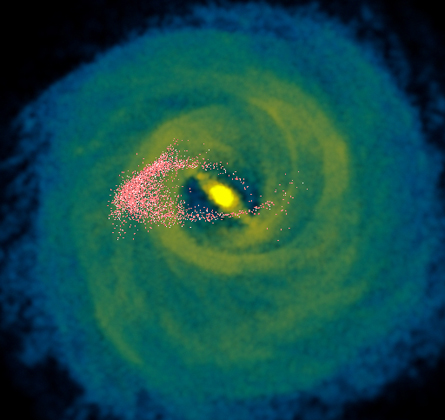
A new study has identified stellar crumbs from what may be the Milky Way’s most recent meal — a dwarf galaxy devoured about 700 million years ago. The discovery provides fresh evidence for the leading theory of galaxy formation, which holds that the Milky Way and other large, modern-day galaxies began small and continue to grow by consuming or merging with their neighbors.
The stream of 15 stars discovered by Mary Williams of the Astrophysical Institute Potsdam in Germany and her colleagues all have similar speeds and chemical compositions. It’s those shared properties that set the elongated grouping of stars, located in the constellation Aquarius, apart from the 250,000 other stars across the Milky Way surveyed by the Australian Astronomical Observatory in Siding Spring, Williams and colleagues report in the Feb. 20 Astrophysical Journal.
The Aquarius star stream is relatively compact, which is a strong clue that the stream hasn’t had time to disperse. Its shape suggests that the stars come from a galaxy that was captured relatively recently and, in the process, stretched like taffy by the Milky Way’s gravity, Williams says. Most of the dozen or so previously identified streams are made up of stars sprinkled throughout the Milky Way and are the remnants of galaxies swallowed billions of years ago.
Because Aquarius is one of the closest known streams, stretching between 1,500 and 30,000 light-years from Earth, astronomers will be able to study it in exceptional detail and accurately determine the mass and other properties of the galaxy it likely came from, Williams says.
She cautions, however, that the 700-million-year estimate for when the Milky Way may have snared the galaxy has an uncertainty of plus or minus 350 million years. “Once more detailed simulations of Aquarius are performed, we’ll have a better grasp of its age and evolution,” Williams says. It’s also possible, she says, that the stream was pulled from a dense packing of stars called a globular cluster rather than from a full-fledged galaxy.
“This is an interesting result in the emerging field of galactic archaeology — understanding the assembly of the Milky Way through the dissection of its stellar populations,” comments Stefan Keller of the Australian National University’s Mt. Stromlo Observatory near Canberra. Each stream, like the rings on a tree, marks another episode in the growth of the Milky Way, he says.
LAST SUPPER
A newly discovered stream of stars (white) depicted in this flyby animation may have been torn from a dwarf galaxy captured by the Milky Way (blue) only about 700 million years ago. The stream covers an area of the sky about 1,300 times that of the full moon as seen from Earth. Credit: Arman Khalatyan/AIP







